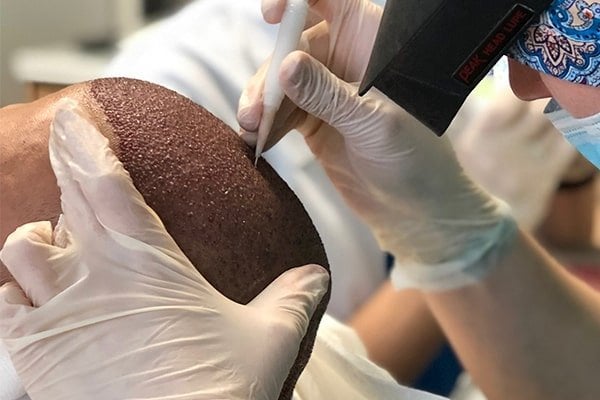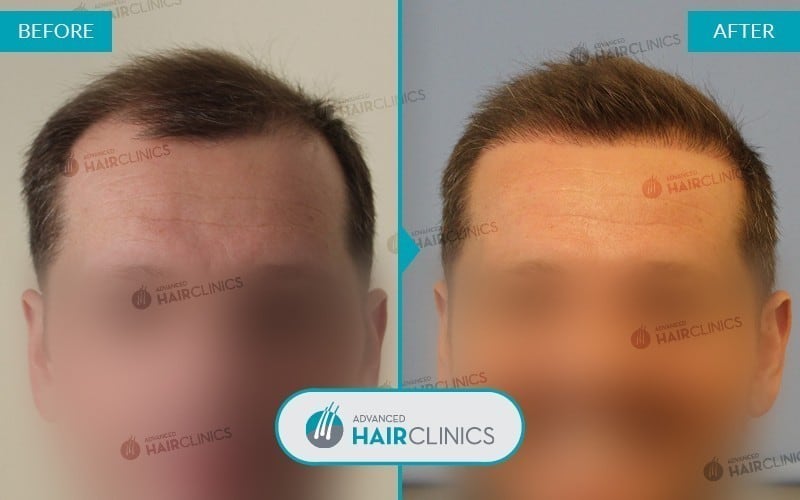Alopecia Areata
Alopecia areata is a pathological, autoimmune condition that affects 1-2% of the population and is characterized by the loss of some or all of the hair, usually from the scalp, beard, eyebrows or even the body.
Usually, alopecia areata is found in the hair and hairs on the beard and eyebrows, but it can occur practically anywhere on the skin where there is hair. The nails also suffer during alopecia areata and show depressions (botrytis) or lineations. The disease may resolve on its own or remain stable in the form of chronic active alopecia areata. Accurate diagnosis is very important for effective treatment.

ALOPECIA AREATA
Symptoms
A key symptom of alopecia areata is that hair is lost in a short period of time, and cases have been reported where the patient loses all their hair overnight. This autoimmune condition affects both sexes with equal frequency, and is most common in children and adolescents.
Typically, the first symptoms of alopecia areata are small round or oval-shaped desquamative plaques – spots on the scalp without any hairs. These plaques usually cause no symptoms, although they may be itchy or slightly painful to the touch. The skin around the site of the alopecia is normal and does not show scarring or other marks.
On clinical examination, the hairs near the alopecia plaque are thin and look like an ‘exclamation mark’ as they thin out more near the root. In active alopecia areata the hairs are easily detached on pulling, and on re-growth the hairs are usually white.

Treatment options for alopecia areata
The treatment of alopecia areata is very important and should not be delayed, as the symptoms of the disease cause severe stress and psychologically aggravate the patients, worsening the condition. With the effective treatments that are now available, patients are improving their quality of life and of course their image. In the case of alopecia areata limited to small lesions, treatment is limited to simply monitoring the problem, as often the problem will repair itself and the hairs will grow back restoring normal hair growth.

Autologous Hair Mesotherapy PRP
The latest addition to the treatment of alopecia areata is the promising autologous PRP hair mesotherapy or hair loss treatment with autologous growth factors. This treatment has been used for years in the treatment of wounds, burns and chronic ulcers, significantly accelerating healing and significantly improving the quality of the scar. In recent years, it has been applied with great success in the treatment of hair loss, both as a conservative treatment and as an adjuvant in combination with hair transplantation.
During PRP treatment, a small amount of the patient’s blood is drawn. The blood is centrifuged and the plasma is isolated. The solution is then activated by the addition of calcium chloride ions, resulting in the secretion of a significant amount of growth factors. The growth factors stimulate the body’s healing power locally, enhancing the proliferation of cells necessary for the healing process and the normal functioning of the skin and its appendages.

Autologous hair mesotherapy is practically painless, as it is performed using a 30G micro-needle and no local anesthesia is required. The session lasts 30-40 minutes and causes no skin irritation. Modern treatment protocols recommend the application of 3-4 sessions with a one month interval between sessions, while it is recommended to carry out a repeat session every 3-6 months.
The response of each patient to the treatment varies, as the first results may appear immediately, even after the first session, but more often the results are visible after the first 2-3 sessions.

PRP Hair Mesotherapy
At Advanced Hair Clinics, autologous hair mesotherapy has been and continues to be applied with great success in many cases of hair loss and alopecia of various etiologies, especially in cases of androgenetic or diffuse alopecia, in both men and women. It has also been applied with impressive results in many cases of alopecia areata, even in cases of universal and generalised alopecia, where the results of classical conservative treatments are usually limited.
Hair loss treatment with autologous growth factors has successfully treated and shown excellent hair regrowth even in cases of universal pollen alopecia in young individuals with a long history of the disease, more than 5 years old, without any previous response to other forms of treatment.
Other available treatments for alopecia areata
RESULTS
Hair loss treatments & Hair transplantation
ALOPECIA AREATA
Hair transplant
Hair transplantation is not considered to have generalised application in the treatment of alopecia areata, particularly in cases of universal alopecia areata where the donor scalp is not sufficient to meet the needs. However, FUE hair transplantation may be used in selected cases of localised pollen alopecia.
Hair transplantation using the FUE technique in a patient with alopecia areata must always be performed after the patient has been fully and thoroughly informed of the nature of the alopecia areata and, in particular, of the fact that the alopecia pareata may recur in the future, in the same or another area, in a manner unpredictable in terms of duration, progression, size or localisation.
Therefore, the patient with alopecia areata should be aware that the results of FUE hair transplantation are stable and permanent in this case, as in other forms of alopecia, provided that the lesions are stable and the disease does not recur in the future.
Suitable for hair transplantation in this case are mainly patients with small, localized and well-defined areas of alopecia areata, who show stability in the progression of the lesion and there is a history of the disease for a sufficient period of time, more than one year, to exclude the possibility of spontaneous hair regrowth in the area of the lesion with a relative certainty. In this case, hair follicles shall be obtained by FUE from the donor site at the back of the scalp and transferred to the lesion site. Sprouting of the hairs in their new position is gradually completed up to 10-12 months after the session and the results of the transplantation are excellent.
A special case of hair transplantation with the FUE method in alopecia areata is the transplantation in the eyebrows, which is a common location of the disease, very often without other areas of the scalp being affected. The results of eyebrow implantation in this case too are excellent and very important for the patient’s psychology, as the loss of eyebrows is very damaging to their self-confidence.
FUE hair transplantation should always be carried out after providing the patient with complete and detailed information about the nature of alopecia areata, and especially the fact that it may recur in the future, in the same or another region and in an unpredictable manner in terms of time, evolution, size or location. Therefore, patients should be aware that the results of FUE hair transplantation are stable and permanent, as in other forms of alopecia, provided that the damage remains stable and does not recur in the future.

Both sexes are affected at the same frequency, while the occurrence of alopecia areata in children and adolescents is more common.
































